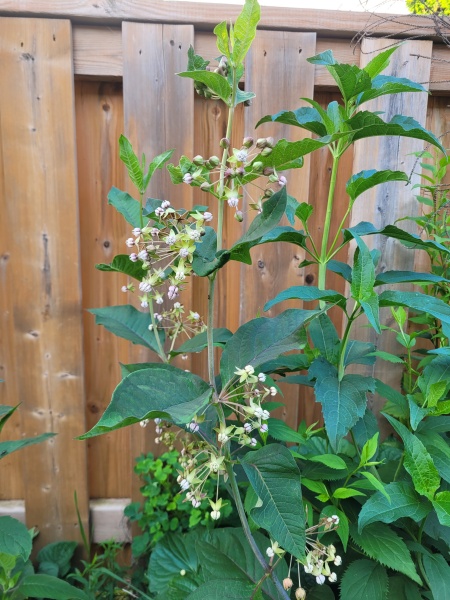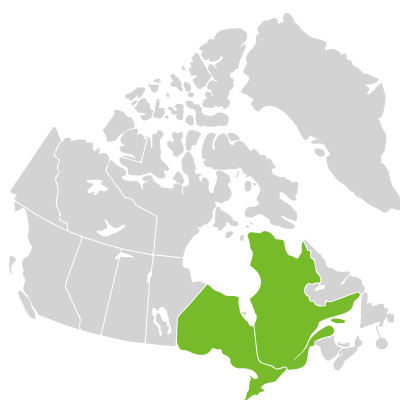 Known to be toxic - Toxic to mammals if ingested.
Known to be toxic - Toxic to mammals if ingested.

Source: Margaret Unger
Asclepias exaltata
Poke Milkweed
Asclépiade très grande
Synonyms
tall milkweed
grande asclépiade
No seeds available for this plant.
We currently accept seeds for this plant
Bloom Colour: White
Bloom Period: Jun - Jul
Max Height: 5.0 feet
Max Width: 3.0 feet (spreads by rhizome)
Light Condition:
 Less than 2 or 3 hours of direct sun a day
Soil conditions:
Less than 2 or 3 hours of direct sun a day
Soil conditions:
 Tolerates medium soil condition
Tolerates medium soil condition
 Less than 2 or 3 hours of direct sun a day
Less than 2 or 3 hours of direct sun a day
 Tolerates medium soil condition
Tolerates medium soil condition
Lifespan:
Perennial
plants that will that come back year after year
Gardener Experience:
 Does not spread uncontrollably
Does not spread uncontrollably
 Does not spread uncontrollably
Does not spread uncontrollably
Landscape Uses:
 Suitable for container garden
Suitable for container garden
 Suitable for woodland gardens
Suitable for woodland gardens
 Tolerates boulevard garden conditions
Tolerates boulevard garden conditions
 Suitable for container garden
Suitable for container garden
 Suitable for woodland gardens
Suitable for woodland gardens
 Tolerates boulevard garden conditions
Tolerates boulevard garden conditions
Ecological Benefits:
 Supports pollinators
Supports pollinators
 Butterfly host
Butterfly host
 Supports pollinators
Supports pollinators
 Butterfly host
Butterfly host
Tolerates:
 Deer resistant
Deer resistant
 Rabbit resistant
Rabbit resistant
 Tolerates limestone conditions
Tolerates limestone conditions
 Tolerates transplantation
Tolerates transplantation
 Deer resistant
Deer resistant
 Rabbit resistant
Rabbit resistant
 Tolerates limestone conditions
Tolerates limestone conditions
 Tolerates transplantation
Tolerates transplantation
Special Features and Considerations:
Plant Location
Distribution according to VASCAN

Ephemeral
Native
Introduced
Excluded
Extirpated
Doubtful
Absent
Thrives in Ecozones
- Boreal Shield
- Mixed Wood Plains
Ecological Benefits
Butterflies Supported by Asclepias exaltata
- Danaus plexippus (Monarch)
- Trichordestra legitima (Striped Garden Caterpillar)
Specialized Bees Supported by Asclepias exaltata
No bee data available for this plant.
Plants that grow in similar conditions, that bloom at the same time.
Complementary Plants
- No complementary plants found.
Substitute For Non-Native Plants
- Hydrangea (Hydrangea)
- Asclepias (Milkweed Cultivars)
- Asclepias curassavica (Tropical Milkweed)
Sowing Information
Download Seed Envelope Labels (PDF)
- Sowing depth: Sow just below surface
- Sow by March
- Stratification duration: 30 days
Harvesting and Seed Sharing
- Harvest start month: September
- Harvesting indicator:
- Pods are slightly open and seeds inside are dark
- Harvesting:
- Use hand to detach from main stem
- Seed viability test:
- No test needed before donating
- Packaging measure: 1 rounded 1/8 teaspoon
- Seed storage:
- Air dry in paper bag or open container, for a few days until crisp
- Shake seeds to move them once in a while to prevent molding
- Cultivar: No, you can donate without knowing the source as there are only straight species
- Remove non-seed material
- No harvesting video available at this time.
Toxicity Notes
Toxic to mammals if ingested.


 Canadensis
Canadensis
